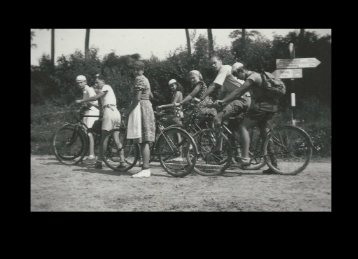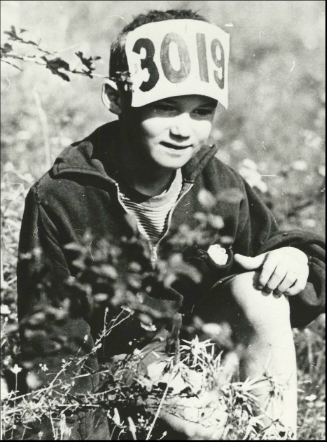A very serious play at the lake
EXHIBITION
“Counter-pedagogy on the lakeside” is the title of the new exhibition in the Museum of Ethnography in Budapest introducing the visitor into the unique world of a summer camp.
What was reform pedagogy and private education like before the Second World War? How much did the authoritarian regimes tolerate alternative education in Hungary? When were the children republics established, and what was time-keeping like in them? What was the definition of coolness? All these questions are addressed in this new exhibition, which goes deep into the history of a summer camp continuously existing between 1938 and 1978.

“I believe in the power of quite words.”
The organizer of this summer camp, Eszter Leveleki, was a teacher in the best sense of the word. She was looking for ways to build up norms within a community with the help of simple gestures, everyday objects, fallible humans or whatever mundanity she found in the world around her. These are her own words about this:
“It’s eternal truth that if we can name something, then we are not afraid of it any more, we can handle it more freely and in a way it belongs to us. This is not only true for objects, but for adults and children too. (…) A teacher is the artist of the miniscule. The quite words or even silence are very important, they are much more powerful than shouting. Children get scared of shouting, but are compelled to listen to quiet words. I believe in quite words.”
The mythology of this summer camp has been maintained primarily by those who took part in it. It was the fieldwork done by AnBlokk, a small Hungarian NGO specialising in social and cultural research, which shed more light on Eszter Leveleki’s work and on the peculiar world of her summer camps. AnBlokk and the museum together ventured into this world to create an exhibition which turns the camp leader’s life and the world she created with the children into a museum experience. With the help of interviews, documents and objects, the exhibition offers a narrative which depicts the camp’s unique world and its own time structure. Within this world the participants received nicknames, and, together with this, a special identity which only existed in Bánk, and which differed a lot from their childhood roles at home. This utopia became a reality for the children at the moment they arrived at Bánk, the little village with a picturesque lake 50 km from Budapest.
 “The game was not organised correctly”
“The game was not organised correctly”
In Bánk, every year children kept a diary which turned out to be one of the most important sources for the exhibition. The entry on 16 July 1954 narrates a conflict in a very specific child-language. It can clearly illustrate what serious play means, and how misunderstandings can develop into real conflicts. The diary says on this day: “Around lunchtime they sky cleared up and the children were very happy because the girls’ gymnastics competition was due on this day. However, the wheel of Fortune, and Medve [one of the older children] decided that it was not going to be a gymnastics competition, but a game we all whole-heartedly welcomed. In this game we continued the fight between the legionnaires and the Tuareg. The legionnaires’ task was to enter the Tuareg Empire and obtain their treasure. This fight demanded ‘cyclopsian and titanic’ strength, which did exist, just they could not use them properly. The Tuareg leader was Bid [another older child] who was eager to explain the rules, but he failed because, due to his own and Medve’s fault, he misunderstood them. No wonder that most of the players went hiding outside the designated play area. Then Medve, the leader of the legionnaires, and his forces started to march towards the target. When they finally got to the little house they realised that the game had not been organised properly. Some of the legionnaires were irritated that all their efforts were in vain. In the meantime, I, who was in the Arabic army, ventured into the woods and was walking towards the children. However, due to peculiar circumstances, I got lost and an expedition was set up to find me. The children were fighting hard with the bush and the thorns before they actually reached me and we proceeded back to the little house. When we got down, a bro was joyfully explaining how many things they had to struggle with, which provoked a fight and some legionnaires started to beat him up. Then Ferkó went up to them to see what was going on, but they, without a single word, involved him, namely they started to beat him up too. Later the fight stopped, and they started to argue about the causes. The argument became stormy and they all agreed to hold a discussion after dinner. The supper ended pretty quickly and we settled to a table to discuss the events. Eszter said that such a thing that a game had gone wrong for any reason had never happened in the history of the camp. Now, I am going to summarise the causes, the problems and the mistakes. Firstly, everybody turned out to be undisciplined and there was no collective solidarity. The children did not know the aim of the game and did everything mindlessly.”
The misunderstandings blurred the boundary between the game and reality. The real and the symbolic misunderstanding not only disrupted the process of the game, in other words the normative activity of the community, but it also affected, through the roaming in the woods and the conflict between the children, the individual integrity. The dispute was finally settled by involving the only adult in the camp: however, the conflict being rooted in a badly organised game is clear from the lines of the diary.
“I learnt to play in Bánk.”
At the end of the 1950s the games were characterised by a kind of wild cowboy romanticism. The basic games like football, button football, hide and seek, or chess remained regular programmes during the decades, but in the 1960s games aiming to widen the children’s cultural horizon was becoming more and more prevalent. These games often reflected with an ironic tone on the world outside the camp, on social and political events. Nevertheless, the core concepts of the camp remained community ethos, spontaneity and creativity, but it increasingly manifested itself in art performances.
“I learnt to play in Bánk. And this is very important! It’s not about defending a castle or playing hide and seek or chess: I learnt to take games seriously. And what I never experienced anywhere else, I learnt to switch from the game into reality or from one game to the other in a second.
The exhibition is open until 30 August 2015.
Curator: Zsófia Frazon
Co-curators: Melinda Kovai, Eszter Neumann, Zsolt K. Horváth, András Vigvári, Margit Barna, Veronika Hermann
Exhibition design: David Karas
Typography and graphic design: Gábor Dávid